Leaf-mining moths
Some of the smallest moths have larvae that feed inside the foliage of their host plants, eating the soft plant tissue between the tougher upper and lower leaf epidermis. They often cause distinctive discoloured areas where the internal leaf tissues have been consumed. Leaf-mining moths occur in several families within the Lepidoptera. Other insect orders with some leaf-mining species are the Diptera, Coleoptera and Hymenoptera.
Species in Britain and Ireland
All the leaf-mining moths are "micros" as their diminutive size would suggest. Most leaf-mining moths are associated with forest trees and wild flowers but some feed as larvae in the foliage of garden plants, and are often quite specific to one or two species. Some of these moths and their mines are shown below.
- Home
- Garden Wildlife
- Insects
- Lepidoptera
- Leaf-mining moths
Carnation tortrix moth Cacoecimorpha pronubana larva, note the silk patches which held the leaf sides together. The adult moth on the right.
Some other micro-moths have a related habit of feeding within leaves, but by rolling them over and sticking them together with silk to provide hiding space while feeding on the upper part of the leaf only. The carnation tortrix moth above is one such example .
Biology
The caterpillars of leaf-mining moths feed between the upper and lower epidermis of leaves. In doing so, they create mines that show up as white or brownish discoloured lines or blotches. The pattern of the mine is fairly constant for a particular species of leaf miner. In some species, such as apple leaf-mining moth, it is a linear tunnel that often twists and turns as the larva moves within the leaf. Laburnum leaf-mining moth larvae make circular mines. Pyracantha leaf-mining moth larvae make oval mines on the upper leaf surface. Lilac leaf-mining moth larvae start by creating a communal blotch mine but as they grow larger, they leave the mine and use silk threads to roll the leaf tip. They complete their feeding within the rolled leaf. Other species create irregular blotch mines or a combination of linear and blotch mines.
Some leaf-mining moth larvae n influence the physiology of the leaf tissues around their mines. In autumn, when leaves on deciduous trees take on their autumnal colours, some leaf miners secrete chemicals that make the leaves retain a green area around the leaf mines. This is particularly noticeable with some leaf-mining moths on oak and beech.
Life cycle
Leaf-mining moths lay their eggs on or in the foliage of suitable host plants. After hatching, the larvae tunnel through the internal leaf tissues. When they have completed their feeding, the larvae of some species pupate within the foliage but in others the larvae exit the mines and pupate elsewhere on the plant or in the soil. Some species, such as horse chestnut leaf-mining moth and apple leaf-mining moth, have several generations a year. Leaf-mining moths overwinter as pupae, larvae or adults, depending on the species.
Role of leaf-mining moths in gardens
Leaf-mining moth larvae that feed in the foliage of garden plants may cause sufficient damage to their host plants for them to be regarded as pests. In most cases, however, the damage is more of a cosmetic nature and is unlikely to affect the plants’ growth. Horse chestnut leaf-mining moth is an invasive species originating in Macedonia within the native range of the horse chestnut tree Aesculus hippocastrum. It has spread rapidly through Europe, where the horse chestnut has been extensively plantedand was first recorded in Britain in 2002.
_(14061516834).jpg)
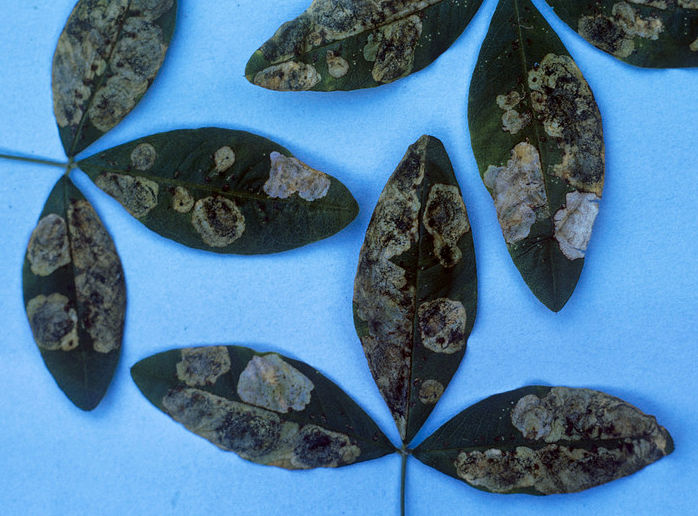
Laburnum leaf-mining moth, Leucoptera laburnella on laburnum Laburnum species and pineapple broom Cytisus battandieri
Apple leaf-mining moth, Lyonetia clerkella, found on apple and cherry
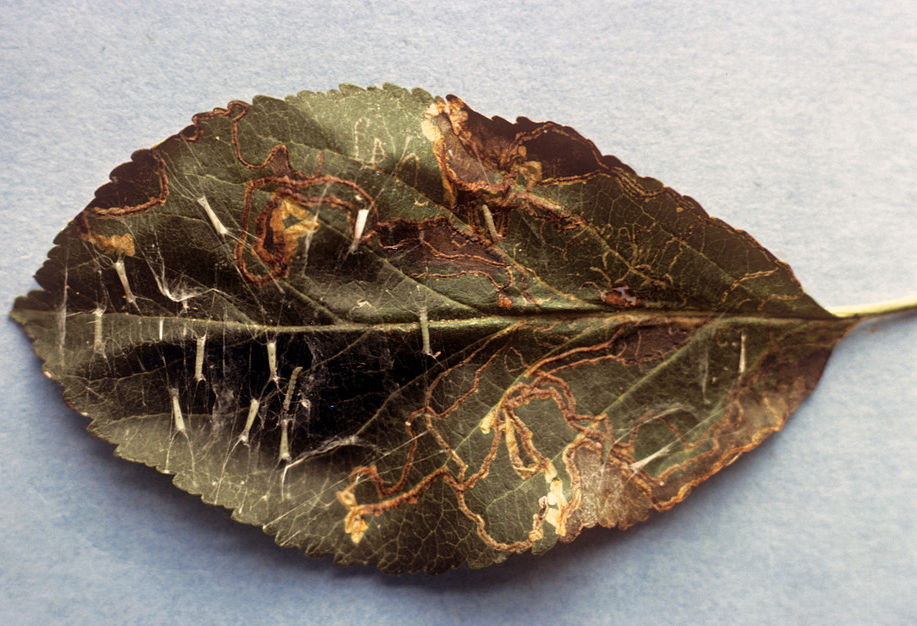
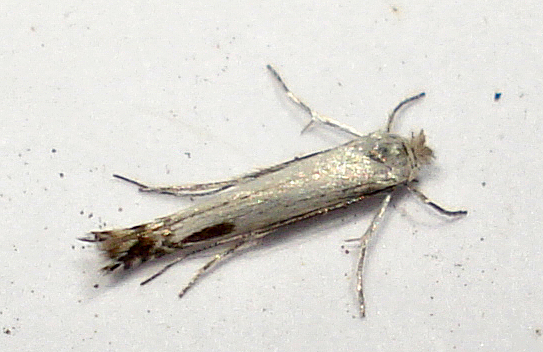
Lilac leaf-mining moth, Gracillaria syringella, on lilac and privet. This species can be abundant in some years.
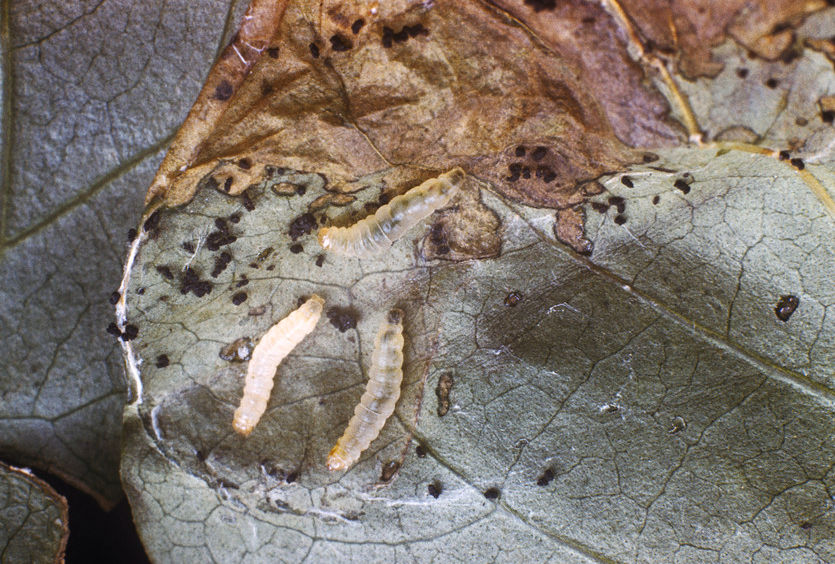
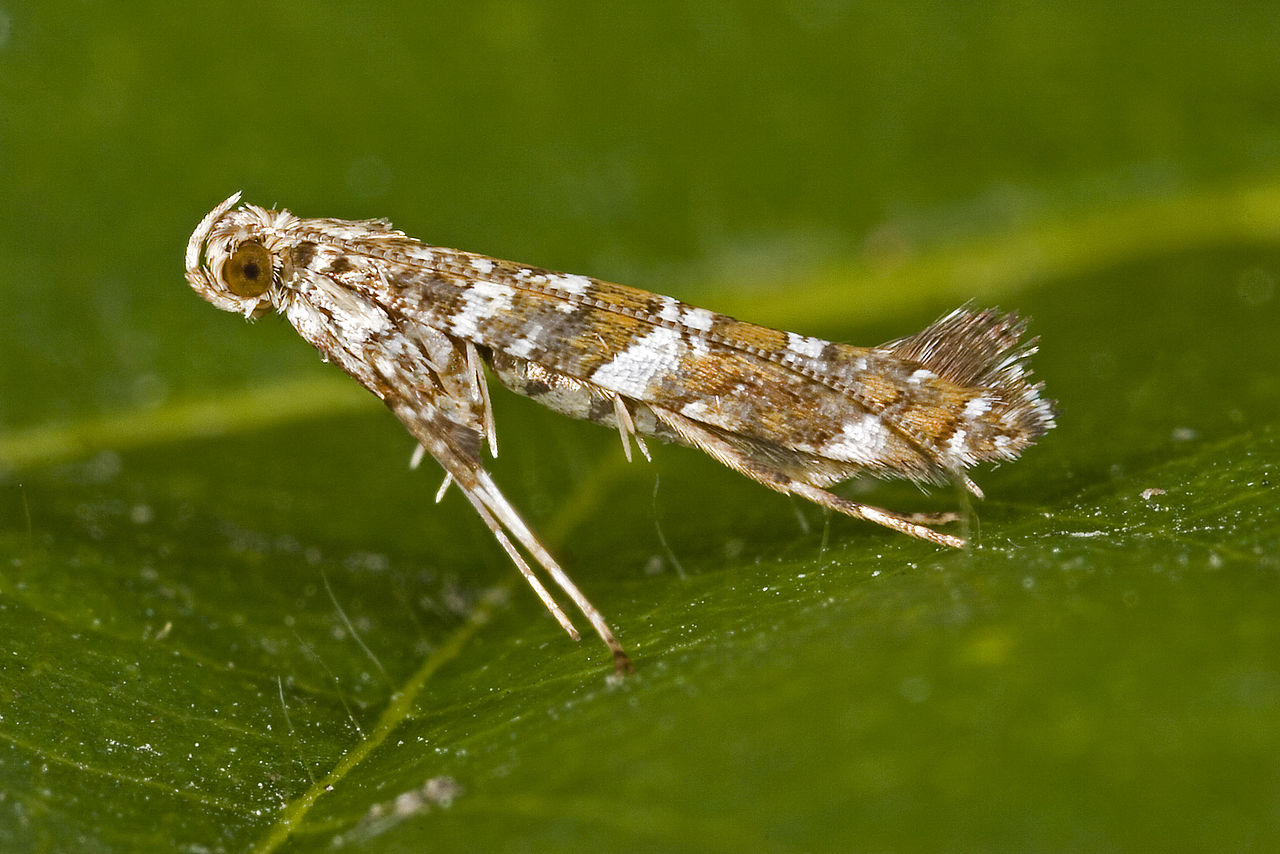
Pyracantha leaf-mining moth, Phyllonorycter leucographella, on Pyracantha
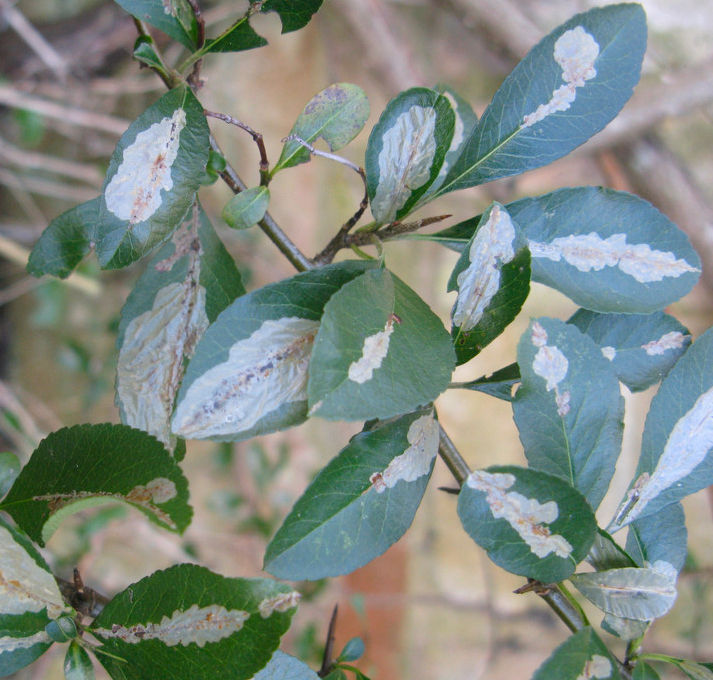
.jpg)
.jpg)
Leek moth Acrolepiopsis assectella, which feeds on onions and leeks, mainly in the south of England, but is spreading north
.jpg)
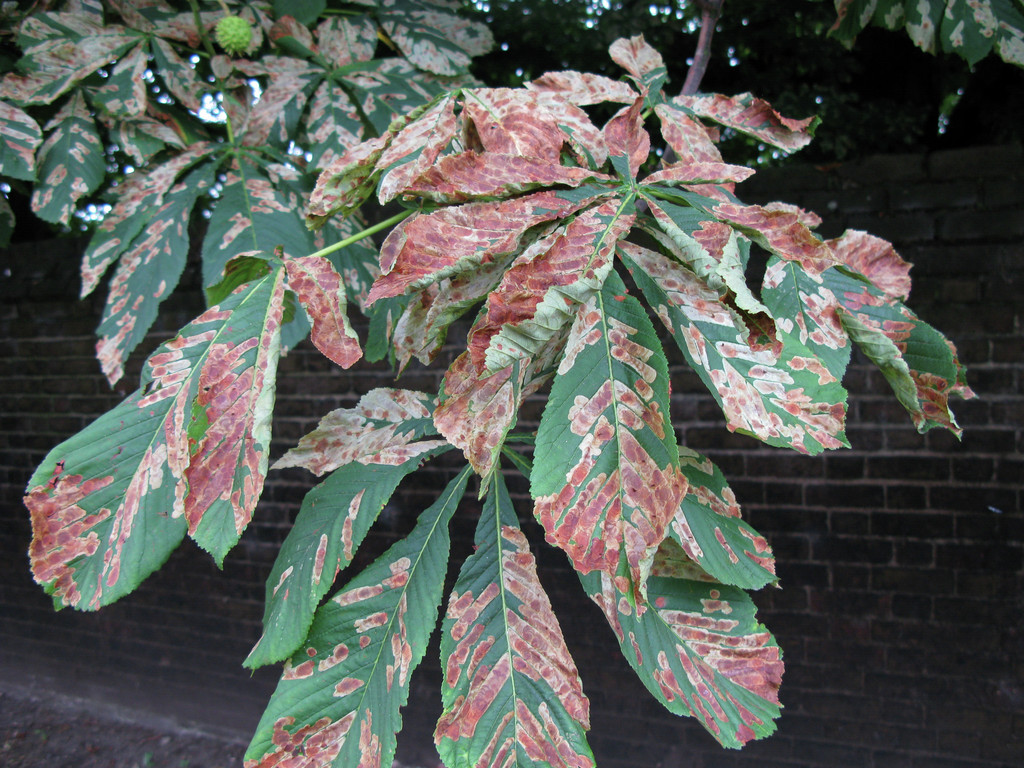
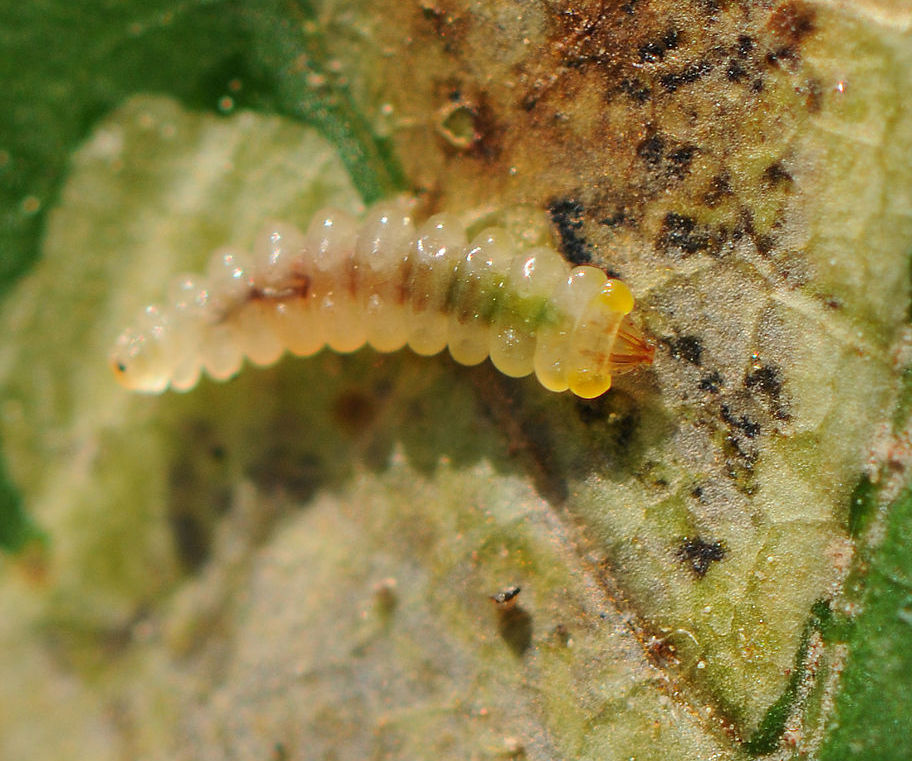
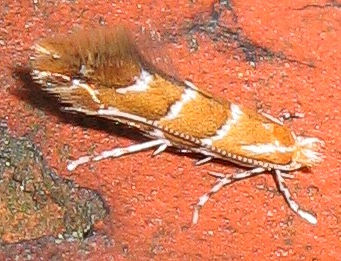
Horse chestnut leaf-mining moth Cameraria ohridella. Above left, typical damage to foliage. Above right: larva. Right: adult moth.
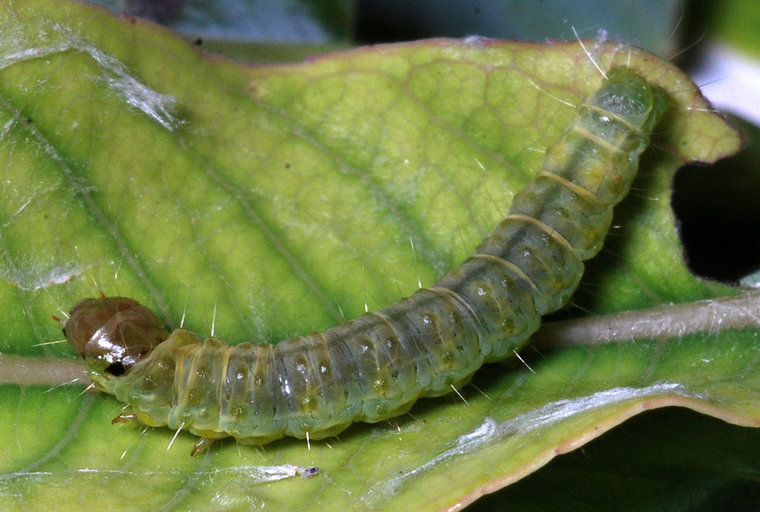
![Carnation tortrix moth Cacoecimorpha pronubana Photo: Ben Sale from UK [CC BY 2.0 (https://creativecommons.org/licenses/by/2.0)]](images/(0985)_Cacoecimorpha_pronubana_(17986534826).jpg)
Left: Spread of horse chestnut leaf-miner since 1984
By August, most of the foliage on horse chestnuts may have gone brown as a result of extensive leaf mining. In spite of this, the tree is able to survive as it does most of its growth in spring-early summer before heavy infestations have developed.
Other species of Aesculus are not affected. Aesculus indica is the closest in size and appearance if a replacement tree is required.
Note that horse chestnut leaf blotch can look similar, although it does not tend to align to leaf veins. It is caused by the fungus Phyllosticta paviae.
Other sources of information
Websites
Website of British leaf-mining insects
Website of UK Moths
RHS information on lilac leaf-miner moth
RHS information on apple leaf-miner moth
RHS information on leek moth
RHS information on laburnum leaf-miner moth
RHS information on pyracantha leaf-miner moth
RHS information on horse chestnut leaf-miner moth
RHS information on horse chestnut leaf blotch fungus
Books
Sterling, P., Parsons, M. and Lewington R. (2018) Field Guide to the Micro-moths of Great Britain and Ireland. British Wildlife Publications
Page drafted by Andrew Halstead, reviewed by Andrew Salisbury, edited by Steve Head
![Horse chestnut leaf-miner moth Cameraria ohridella map Photo: Čeština: wikipedista Utar z české WikipedieEnglish: Czech Wikipedia user Utar [CC BY-SA 3.0 (https://creativecommons.org/licenses/by-sa/3.0)]](images/Picture1.jpg)
Leaf-mining moths
Some of the smallest moths have larvae that feed inside the foliage of their host plants, eating the soft plant tissue between the tougher upper and lower leaf epidermis. They often cause distinctive discoloured areas where the internal leaf tissues have been consumed. Leaf-mining moths occur in several families within the Lepidoptera. Other insect orders with some leaf-mining species are the Diptera, Coleoptera and Hymenoptera.
Species in Britain and Ireland
All the leaf-mining moths are "micros" as their diminutive size would suggest. Most leaf-mining moths are associated with forest trees and wild flowers but some feed as larvae in the foliage of garden plants, and are often quite specific to one or two species. Some of these moths and their mines are shown below.
_(14061516834).jpg)
Leaf-mining moths
Some of the smallest moths have larvae that feed inside the foliage of their host plants, eating the soft plant tissue between the tougher upper and lower leaf epidermis. They often cause distinctive discoloured areas where the internal leaf tissues have been consumed. Leaf-mining moths occur in several families within the Lepidoptera. Other insect orders with some leaf-mining species are the Diptera, Coleoptera and Hymenoptera.
Species in Britain and Ireland
All the leaf-mining moths are "micros" as their diminutive size would suggest. Most leaf-mining moths are associated with forest trees and wild flowers but some feed as larvae in the foliage of garden plants, and are often quite specific to one or two species. Some of these moths and their mines are shown below.


Laburnum leaf-mining moth, Leucoptera laburnella on laburnum Laburnum species and pineapple broom Cytisus battandieri
Apple leaf-mining moth, Lyonetia clerkella, found on apple and cherry


Lilac leaf-mining moth, Gracillaria syringella, on lilac and privet. This species can be abundant in some years.

.jpg)
.jpg)
.jpg)
Pyracantha leaf-mining moth, Phyllonorycter leucographella, on Pyracantha

Leek moth Acrolepiopsis assectella, which feeds on onions and leeks, mainly in the south of England, but is spreading north


Horse chestnut leaf-mining moth
Cameraria ohridella. Above left, typical damage to foliage. Above right: larva. Right: adult moth.

![Carnation tortrix moth Cacoecimorpha pronubana Photo: Ben Sale from UK [CC BY 2.0 (https://creativecommons.org/licenses/by/2.0)]](images/(0985)_Cacoecimorpha_pronubana_(17986534826).jpg)
Carnation tortrix moth Cacoecimorpha pronubana larva, note the silk patches which held the leaf sides together. The adult moth on the right.
Some other micro-moths have a related habit of feeding within leaves, but by rolling them over and sticking them together with silk to provide hiding space while feeding on the upper part of the leaf only. The carnation tortrix moth above is one such example .
Biology
The caterpillars of leaf-mining moths feed between the upper and lower epidermis of leaves. In doing so, they create mines that show up as white or brownish discoloured lines or blotches. The pattern of the mine is fairly constant for a particular species of leaf miner. In some species, such as apple leaf-mining moth, it is a linear tunnel that often twists and turns as the larva moves within the leaf. Laburnum leaf-mining moth larvae make circular mines. Pyracantha leaf-mining moth larvae make oval mines on the upper leaf surface. Lilac leaf-mining moth larvae start by creating a communal blotch mine but as they grow larger, they leave the mine and use silk threads to roll the leaf tip. They complete their feeding within the rolled leaf. Other species create irregular blotch mines or a combination of linear and blotch mines.
Some leaf-mining moth larvae n influence the physiology of the leaf tissues around their mines. In autumn, when leaves on deciduous trees take on their autumnal colours, some leaf miners secrete chemicals that make the leaves retain a green area around the leaf mines. This is particularly noticeable with some leaf-mining moths on oak and beech.
Life cycle
Leaf-mining moths lay their eggs on or in the foliage of suitable host plants. After hatching, the larvae tunnel through the internal leaf tissues. When they have completed their feeding, the larvae of some species pupate within the foliage but in others the larvae exit the mines and pupate elsewhere on the plant or in the soil. Some species, such as horse chestnut leaf-mining moth and apple leaf-mining moth, have several generations a year. Leaf-mining moths overwinter as pupae, larvae or adults, depending on the species.
Role of leaf-mining moths in gardens
Leaf-mining moth larvae that feed in the foliage of garden plants may cause sufficient damage to their host plants for them to be regarded as pests. In most cases, however, the damage is more of a cosmetic nature and is unlikely to affect the plants’ growth. Horse chestnut leaf-mining moth is an invasive species originating in Macedonia within the native range of the horse chestnut tree Aesculus hippocastrum. It has spread rapidly through Europe, where the horse chestnut has been extensively planted and was first recorded in Britain in 2002.
![Horse chestnut leaf-miner moth Cameraria ohridella map Photo: Čeština: wikipedista Utar z české WikipedieEnglish: Czech Wikipedia user Utar [CC BY-SA 3.0 (https://creativecommons.org/licenses/by-sa/3.0)]](images/Picture1.jpg)
Spread of horse chestnut leaf-miner since 1984
By August, most of the foliage on horse chestnuts may have gone brown as a result of extensive leaf mining. In spite of this, the tree is able to survive as it does most of its growth in spring-early summer before heavy infestations have developed.
Other species of Aesculus are not affected. Aesculus indica is the closest in size and appearance if a replacement tree is required.
Note that horse chestnut leaf blotch can look similar, although it does not tend to align to leaf veins. It is caused by the fungus Phyllosticta paviae.
Other sources of information
Websites
Website of British leaf-mining insects
Website of UK Moths
RHS information on lilac leaf-miner moth
RHS information on apple leaf-miner moth
RHS information on leek moth
RHS information on laburnum leaf-miner moth
RHS information on pyracantha leaf-miner moth
RHS information on horse chestnut leaf-miner moth
RHS information on horse chestnut leaf blotch fungus
Books
Sterling, P., Parsons, M. and Lewington R. (2018) Field Guide to the Micro-moths of Great Britain and Ireland. British Wildlife Publications
Page drafted by Andrew Halstead, reviewed by Andrew Salisbury, edited by Steve Head
Spread of horse chestnut leaf-miner since 1984
By August, most of the foliage on horse chestnuts may have gone brown as a result of extensive leaf mining. In spite of this, the tree is able to survive as it does most of its growth in spring-early summer before heavy infestations have developed.
Other species of Aesculus are not affected. Aesculus indica is the closest in size and appearance if a replacement tree is required.
Note that horse chestnut leaf blotch can look similar, although it does not tend to align to leaf veins. It is caused by the fungus Phyllosticta paviae.












